Thermal Performance of a Low-Temperature Heat Exchanger Using a Micro Heat Pipe Array
Abstract
:1. Introduction
2. Materials and Methods
2.1. Low-Temperature Flue Gas Heat Exchanger Based on Microthermal Tube Array
2.1.1. Micro Heat Tube Array
2.1.2. Low-Temperature Flue-Gas Heat Recovery Device of the Microthermal Tube Array
2.2. Thermal Performance Test of Low-Temperature Flue Gas Heat Exchanger in Microthermal Tube Array
2.2.1. Data Measurement of Low-Temperature Flue Gas Heat Exchanger in Microthermal Tube Array
2.2.2. The Test System of Low-Temperature Flue Gas Heat Exchanger in Microthermal Tube Array
2.2.3. Experimental Process
3. Results and Analysis
3.1. Results and Analysis of Heat Exchange Test of Low-Temperature Flue Gas Heat Exchanger in Microthermal Tube Array
3.2. Performance of Low-Temperature Flue Gas Heat Exchanger in Microthermal Tube Array
4. Discussion
4.1. Pressure Analysis
4.2. Error Analysis
- (1)
- The gas flow state was different; in the actual process, the airflow did not achieve a steady state due to structural and other factors. In theoretical design, flow state was assumed unchanged.
- (2)
- The smoke design parameters were different; the actual smoke composition was complex, and the proportion of each component varied with time. In theoretical calculations, the exhaust gas form, composition, and proportion were fixed, thereby introducing a significant bias in the results.
- (3)
- The accuracy errors in the measuring instrument; the measuring instruments could have brought errors due to external weather factors and human operation.
4.3. Heat Exchanger Simulation and Analysis
4.4. Numerical Calculation Model of the Heat Exchanger
4.4.1. Physical Model
4.4.2. Relevant Assumptions and Simplifications
- (1)
- The fluid was considered incompressible.
- (2)
- The thermal effect of viscous dissipation in fluid flow was ignored.
- (3)
- The physical quantities of the flow do not change with time and are assumed to be in the steady flow.
- (4)
- The internal fluid flow in the micro heat pipe array was assumed to be equivalent to a solid block with the same heat transfer coefficient as the medium.
- (5)
- The effect of the fin on the heat exchanger performance was not significant; thus, the effect of the fin was ignored.
4.4.3. Boundary Conditions
4.5. Results of Numerical Simulation
- (1)
- The indoor temperature was 22 °C; with the improvement of the inlet temperature of fresh air, the heat between the fresh air and indoor one decreased gradually, which led to the abatement of the indoor heat transfer, thereby reducing the tail deviation, as shown in Figure 12.
- (2)
- The simulation and measured results increased with increasing inlet fresh air temperature. This phenomenon can be attributed to errors caused by the experimental conditions, measurement methods and physiological characteristics. In Figure 12, numerical results were more appropriate than the measured ones.
5. Conclusions
Author Contributions
Funding
Conflicts of Interest
Nomenclature
| specific heat of the air (J/(kg K)) | |
| Density of air (kg/m3) | |
| Volume flow of air side (m³/s) | |
| Air side outlet temperature (°C) | |
| Air side outlet temperature (°C) | |
| Fresh air actually gets the heat | |
| Actual wind volume of fresh air (J) | |
| Fresh air terminal heat exchange capacity (m3) | |
| Fresh air constant pressure specific heat (J/(kg K)) | |
| Fresh air inlet temperature (K) | |
| Flue-gas inlet temperature (K) | |
| Air temperature difference (K) | |
| The flue gas actually changes the heat (J) | |
| Actual air volume of flue gas (m3/h) | |
| Heat transfer capacity of flue gas (m3) | |
| Flue-gas constant pressure specific heat (J/(kg K)) | |
| Fresh air outlet temperature (K) | |
| Flue gas outlet temperature (K) | |
| Flue-gas temperature difference (K) | |
| Scaling factor | |
| ρ air | Air density (kg/m3) |
| t0 | Average temperature of fresh air |
| () | Flue-gas average temperature () |
| u | Velocity component in the x direction (m/s) |
| v | Velocity component in the y direction (m/s) |
| w | Velocity component in the z direction (m/s) |
| i | On behalf of the direction |
| Ui | Velocity component in that direction (m/s) |
| ρ | Fluid density (kg/m3) |
| P | Partial pressure (Pa) |
| μ | Dynamic viscosity (kg/(m·s)) |
| α | Fluid thermal diffusivity (m2/s) |
References
- Building Energy Research Center of Tsinghua University. Annual Report on China Building Energy Efficiency in 2008; China Building Industry Press: Beijing, China, 2008. [Google Scholar]
- Liu, Z.; Liu, Y.; He, B.J.; Xu, W.; Jin, G.; Zhang, X. Application and suitability analysis of the key technologies in nearly zero energy buildings in China. Renew. Sustain. Energy Rev. 2019, 101, 329–345. [Google Scholar] [CrossRef]
- Niu, Y.; Hua, J.; Fan, H. Optimization of the solution heat exchanger of AHP in flue gas waste heat recovery. Procedia Eng. 2017, 205, 477–484. [Google Scholar] [CrossRef]
- Yang, K.S.; Wang, J.S.; Wu, S.K.; Tseng, C.Y.; Shyu, J.C. Performance Evaluation of a Desiccant Dehumidifier with a Heat Recovery Unit. Energies 2017, 10, 2006. [Google Scholar] [CrossRef]
- Galindo, J.; Dolz, V.; Royo-Pascual, L.; Haller, R.; Melis, J. Modelling and Experimental Validation of a Volumetric Expander Suitable for Waste Heat Recovery from an Automotive Internal Combustion Engine Using an Organic Rankine Cycle with Ethanol. Energies 2016, 9, 279. [Google Scholar] [CrossRef]
- Noie-Baghban, S.; Majideian, G. Waste heat recovery using heat pipe heat exchanger (HPHE) for surgery rooms in hospitals. Therm. Eng. 2000, 20, 1271–1282. [Google Scholar] [CrossRef]
- El-Baky, M.A.A.; Mohamed, M.M. Heat pipe heat exchanger for heat recovery in air conditioning. Therm. Eng. 2007, 27, 795–801. [Google Scholar] [CrossRef]
- Li, F.; Duanmu, L.; Fu, L.; Zhao, X.L. Research and Application of Flue Gas Waste Heat Recovery in Co-generation Based on Absorption Heat-exchange. Procedia Eng. 2016, 146, 594–603. [Google Scholar] [CrossRef] [Green Version]
- Sadeghianjahromi, A.; Kheradmand, S.; Nemati, H.; Liaw, J.-S.; Wang, C.-C. Compound Heat Transfer Enhancement of Wavy Fin-and-Tube Heat Exchangers through Boundary Layer Restarting and Swirled Flow. Energies 2018, 11, 1959. [Google Scholar] [CrossRef]
- Tian, L.; He, Y.; Tao, Y.; Tao, W. A comparative study on the air-side performance of wavy fin-and-tube heat exchanger with punched delta winglets in staggered and in-line arrangements. Int. J. Therm. Sci. 2009, 48, 1765–1776. [Google Scholar] [CrossRef]
- Agung, T.W.; Indri, Y.; Muhammad, A.; Takahiko, M.; Shigeru, K. Double-sided delta-wing tape inserts to enhance convective heat transfer and fluid flow characteristics of a double-pipe heat exchanger. Appl. Therm. Eng. 2018, 145, 1359–4311. [Google Scholar]
- Lee, M.-Y.; Kim, Y.; Lee, D.-Y. Experimental Study on Frost Height of Round Plate Fin-Tube Heat Exchangers for Mobile Heat Pumps. Energies 2012, 5, 3479–3491. [Google Scholar] [CrossRef] [Green Version]
- Chen, H.; Wang, Y.; Zhao, Q.; Ma, H.; Li, Y.; Chen, Z. Experimental Investigation of Heat Transfer and Pressure Drop Characteristics of H-type Finned Tube Banks. Energies 2014, 7, 7094–7104. [Google Scholar] [CrossRef] [Green Version]
- Tauscher, R.; Mayinger, F. Heat Transfer Enhancement in a Plate Heat Exchanger with Rib-roughened Surfaces. In Heat Transfer Enhancement of Heat Exchangers; Springer: Dordrecht, The Netherlands, 1999; Volume 4, pp. 207–221. [Google Scholar]
- Xue, Y.; Ge, Z.; Du, X.; Yang, L. On the Heat Transfer Enhancement of Plate-Fin Heat Exchanger. Energies 2018, 11, 1398. [Google Scholar] [CrossRef]
- Maakoul, A.E.; Laknizi, A.; Saadeddine, S.; Abdellah, A.B.; Meziane, M.; Metoui, M.E. Numerical design and investigation of heat transfer enhancement and performance for an annulus with continuous helical baffles in a double-pipe heat exchanger. Energy Convers. Manag. 2017, 133, 76–86. [Google Scholar] [CrossRef]
- Ma, T.; Li, L.; Xu, X.Y.; Chen, Y.T.; Wang, Q.W. Study on local thermal–hydraulic performance and optimization of a zigzag-type printed circuit heat exchanger at high temperature. Energy Convers. Manag. 2015, 104, 55–66. [Google Scholar] [CrossRef]
- Hasan, M.I.; Rageb, A.A.; Yaghoubi, M.; Homayoni, H. Influence of channel geometry on the performance of a counter flow microchannel heat exchanger. Int. J. Therm. Sci 2009, 48, 1607–1618. [Google Scholar] [CrossRef]
- Zhang, L.; Che, D. Influence of corrugation profile on the thermal-hydraulic performance of cross-corrugated plates. Numer. Heat Tran. Part A Appl. 2011, 59, 267–296. [Google Scholar] [CrossRef]
- Sui, Y.; Teo, C.J.; Lee, P.S. Direct numerical simulation of fluid flow and heat transfer in periodic wavy channels with rectangular cross-sections. Int. J. Heat Mass Trans. 2012, 55, 73–88. [Google Scholar] [CrossRef]
- Focke, W.W. Asymmetrically corrugated plate heat exchanger plates. Int. Commun. Heat Mass Trans. 1985, 12, 67–77. [Google Scholar] [CrossRef]
- Stasiek, J.M.; Collins, W.; Ciofalo, M.; Chew, P.E. Investigation of flow and heat transfer in corrugated passages—I. Experimental results. Int. J. Heat Mass Trans. 1996, 39, 149–164. [Google Scholar] [CrossRef]
- Elshafei, E.A.M.; Awad, M.M.; El-Negiry, E.; Ali, A.G. Heat transfer and pressure drop in corrugated channels. Energy 2010, 35, 101–110. [Google Scholar] [CrossRef]
- Ismail, L.S.; Velraj, R.; Ranganayakulu, C. Studies on pumping power in terms of pressure drop and heat transfer characteristics of compact plate-fin heat exchangers—A review. Renew. Sustain. Energy Rev. 2010, 14, 478–485. [Google Scholar] [CrossRef]
- Song, K.; Tagawa, T. The optimal arrangement of vortex generators for best heat transfer enhancement in a flat-tube-fin heat exchanger. Int. J. Therm. Sci. 2018, 132, 355–367. [Google Scholar] [CrossRef]
- Song, K.W.; Xi, Z.; Su, M.; Wang, L.C.; Wu, X.; Wang, L.B. Effect of geometric size of curved delta winglet vortex generators and tube pitch on heat transfer characteristics of the fin-tube heat exchanger. Exp. Fluid Sci. 2017, 82, 8–18. [Google Scholar] [CrossRef]
- Tiggelbeck, S.; Mitra, N.K.; Fiebig, M. Comparison of wing-type vortex generators for heat transfer enhancement in channel flows. ASME J. Heat Trans. 1994, 116, 880–885. [Google Scholar] [CrossRef]
- Wu, J.M.; Tao, W.Q. Numerical study on laminar convection heat transfer in a channel with longitudinal vortex generator, Part B: A parametric study of major influence factors. Int. J. Heat Mass Trans. 2008, 51, 3683–3692. [Google Scholar] [CrossRef]
- Deng, Y.C.; Quan, Z.H.; Zhao, Y.H.; Wang, L.C. Experimental investigations on the heat transfer characteristics. Sci. China Technol. Sci. 2013, 5, 1177–1185. [Google Scholar] [CrossRef]
- Yang, W.; Zhao, D.; Wang, X.; Jiang, L. Economic analysis and calculations of low-temperature gas waste heat recovery by heat pipe technology. Ind. Furn. 2012, 1, 46–49. [Google Scholar]
- Chen, H.; Zhang, H.; Li, M.; Liu, H.; Huang, J. Experimental investigation of a novel LCPV/T system with micro-channel heat pipe array. Renew. Energy 2018, 115, 773–782. [Google Scholar] [CrossRef]
- Milani, M.; Montorsi, L.; Terzi, S. Numerical analysis of the heat recovery efficiency for the post-combustion flue gas treatment in a coffee roaster plant. Energy 2017, 141, 729–743. [Google Scholar] [CrossRef]
- Jabari, F.; Mohammadi-Ivatloo, B.; Li, G.; Mehrjerdi, H. Design and performance investigation of a novel absorption ice-making system using waste heat recovery from flue gases of air to air heat pump. Appl. Therm. Eng. 2018, 130, 782–792. [Google Scholar] [CrossRef]
- Hu, G.; Yue, Y. Research and practice on recover boiler waste heat by reduce the exhaust gas temperature. Energy Conserv. Technol. 2012, 4, 295–298. [Google Scholar]
- Solanki, S.C.; Dubey, S.; Tiwari, A. Indoor simulation and testing of photovoltaic thermal (PV/T) air collectors. Appl. Energy 2009, 86, 2421–2428. [Google Scholar] [CrossRef]
- Mou, B.; He, B.J.; Zhao, D.X.; Chau, K.W. Numerical simulation of the effects of building dimensional variation on wind pressure distribution. Eng. Appl. Comput. Fluid Mech. 2017, 11, 293–309. [Google Scholar] [CrossRef] [Green Version]
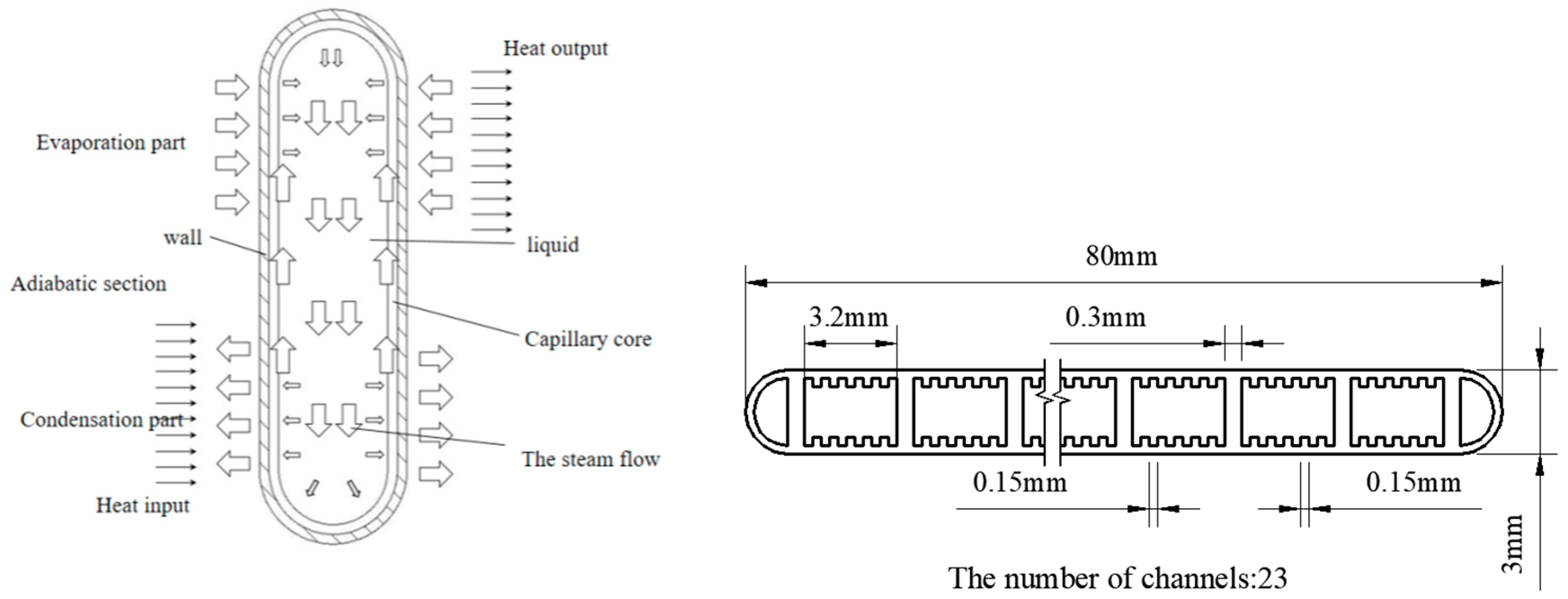


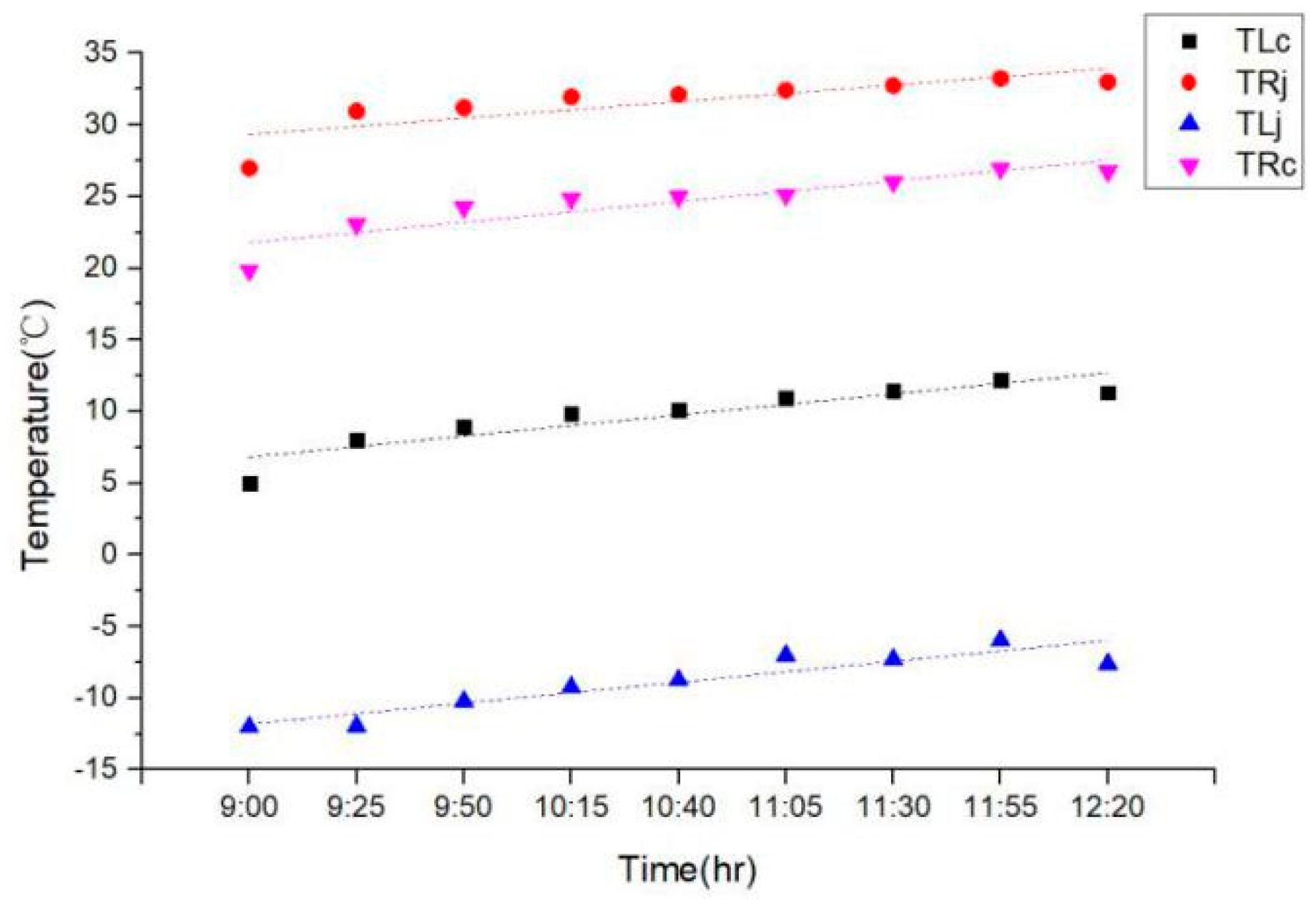
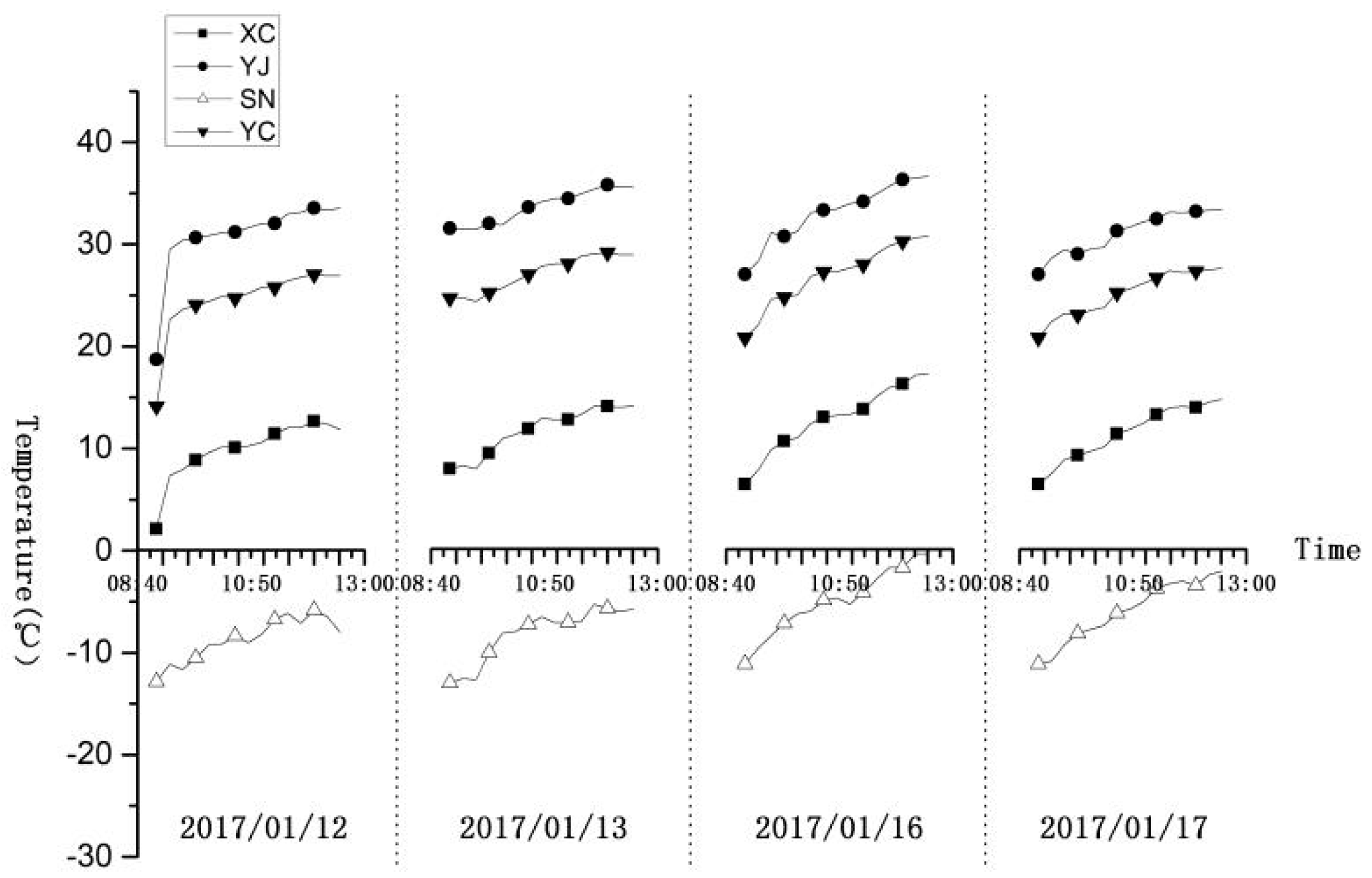

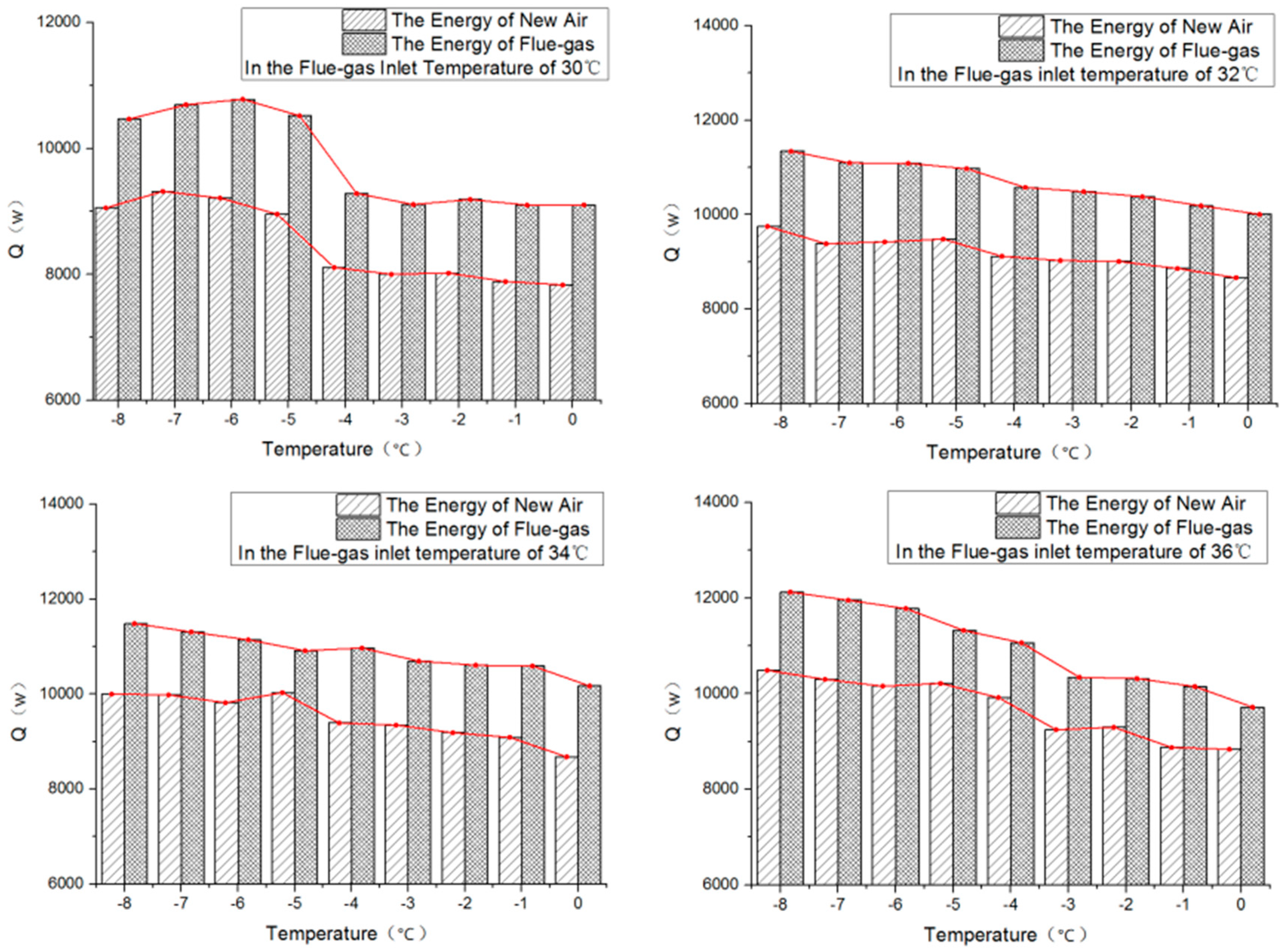

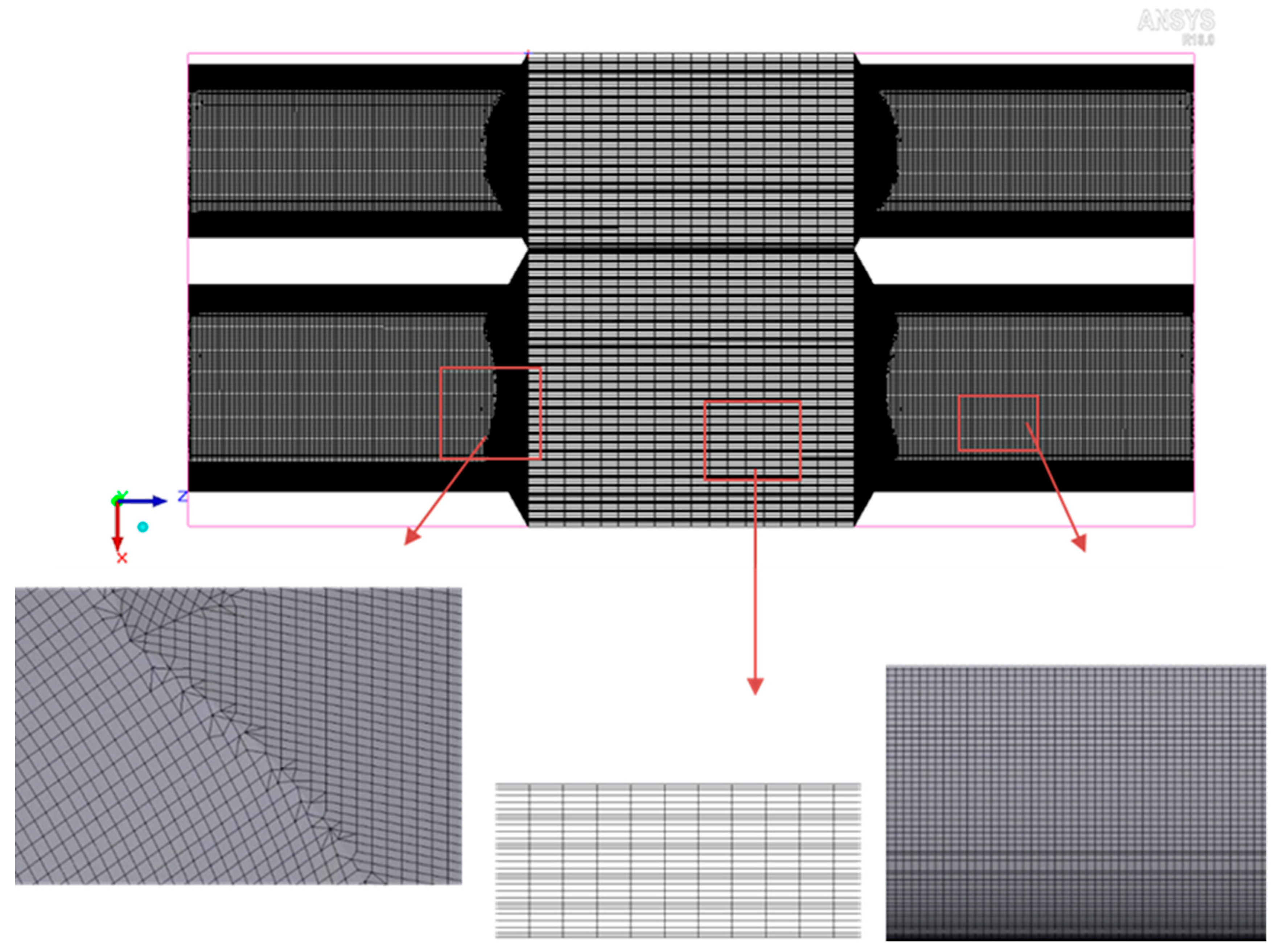


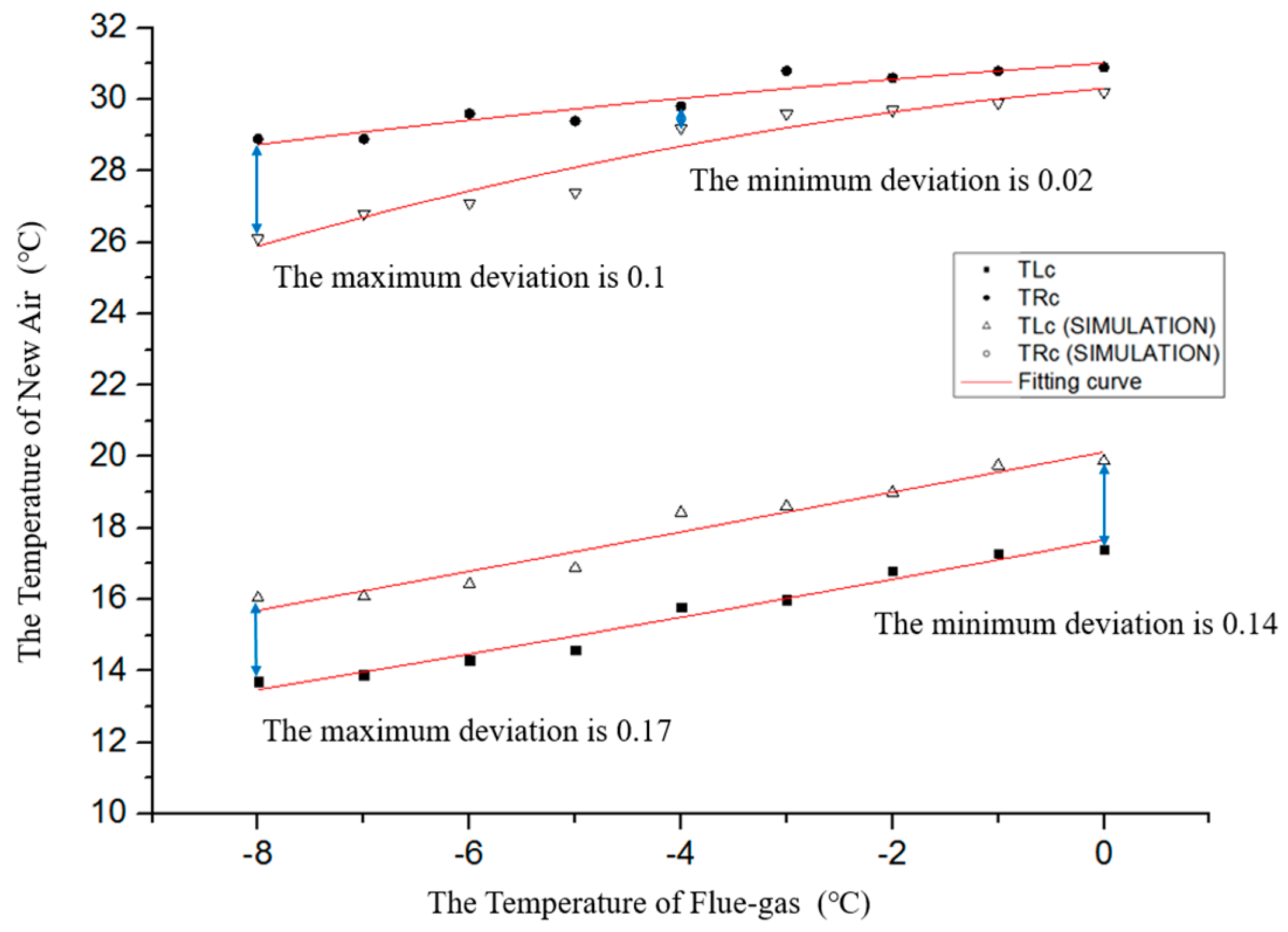
| Characteristic Parameters | Value of Number | Measurement Unit |
|---|---|---|
| Overall dimensions | 685 × 475 × 490 | mm × mm × mm |
| The number of microthermal tube arrays | 126 | |
| Single piece effective heat transfer area. | 0.106 | m2 |
| The thickness of the segment | 4 | mm |
| Plate spacing | 20 | mm |
| Fresh air inlet/outlet area | 0.190 | m2 |
| Polluted air inlet/outlet area | 0.134 | m2 |
| The width of the partition between new and polluted air | 3 | mm |
© 2019 by the authors. Licensee MDPI, Basel, Switzerland. This article is an open access article distributed under the terms and conditions of the Creative Commons Attribution (CC BY) license (http://creativecommons.org/licenses/by/4.0/).
Share and Cite
Yang, J.; Zhao, Y.; Chen, A.; Quan, Z. Thermal Performance of a Low-Temperature Heat Exchanger Using a Micro Heat Pipe Array. Energies 2019, 12, 675. https://doi.org/10.3390/en12040675
Yang J, Zhao Y, Chen A, Quan Z. Thermal Performance of a Low-Temperature Heat Exchanger Using a Micro Heat Pipe Array. Energies. 2019; 12(4):675. https://doi.org/10.3390/en12040675
Chicago/Turabian StyleYang, Jingang, Yaohua Zhao, Aoxue Chen, and Zhenhua Quan. 2019. "Thermal Performance of a Low-Temperature Heat Exchanger Using a Micro Heat Pipe Array" Energies 12, no. 4: 675. https://doi.org/10.3390/en12040675





